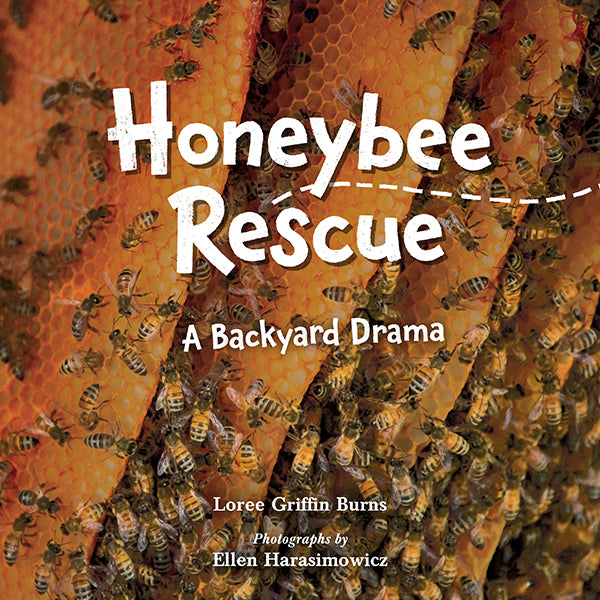Honeybee Rescue

Loree Griffin Burns, author
Loree Griffin Burns is an award-winning writer who holds a PhD in biochemistry. Each of her books draws heavily on both her passion for nature and her experience as a working scientist. She is the author of You're Invited to a Moth Ball, Life on Surtsey: Iceland's Upstart Island, Citizen Scientist: Be a Part of Scientific Discovery in Your Own Back Yard, and Beetle Busters: A Rogue Insect and the People Who Track It.
Read more about Loree.
Ellen Harasimowicz, illustrator
Ellen Harasimowicz has been a professional photographer since 2003. She has made photographs for newspapers and schools, and she has illustrated five children's books, all with Loree Griffin Burns. Ellen loves to travel and photograph far-off places.
Read more about Ellen.
- A Junior Library Guild 2022 selection
- A Kirkus Reviews Best Book of 2022
Kirkus Reviews, starred review
When Mr. Connery, a beekeeper, hears his garage buzzing and finds a colony of bees setting up housekeeping inside, he knows just what to do.
He calls Mr. Nelson, who arrives with his bee-vac, a special vacuum cleaner designed for exactly this situation. Mr. Nelson uses it to gently remove some 35,000 honeybees from the wax comb they’ve built in Mr. Connery’s garage and keep them safe while the two White men reconstitute the bees’ comb in a new hive for Mr. Connery’s garden. Burns, a beekeeper herself, describes the action in vivid, economical prose: “Vacuuming bees requires both patience and stamina.” She interlaces contextual information into her narrative, so readers learn why bees swarm, how they build their hives, and how Mr. Nelson’s bee-vac works even as they follow the riveting story. Harasimowicz’s crisp photos document the process clearly (that it plays out on a gorgeous summer day helps); occasional superimposed arrows with labels orient readers visually. Readers in beekeeping households will note some oversimplification that allows Burns to dive right in to the adventure, but her information is scrupulously accurate after that. They will also observe that Mr. Nelson works without a veil, a fact addressed in a closing Q&A. A glossary, sources, further reading, and acknowledgments round out the backmatter.
Both an excellent nonfiction adventure and a novel addition to honeybee lit
School Library Journal, starred review
In a photographic essay, readers learn what happens when a man finds bees in a place where they just don’t belong. Mr. Connery keeps bees, and one day he discovers some of them have set up a new hive in a barn on his property. Mr. Connery calls a friend, Mr. Nelson, to help him solve this problem. Harasimowicz’s very interesting photographs show the whole process, from discovery to relocation. In beautiful full color, these perfectly show off the bees and their hives—both their own work, and the human-made hives. These images also show the specialized tools the men use to both capture and keep the bees, including a device that Mr. Nelson constructed that works like a vacuum cleaner. The text is simple but very engaging, describing the process clearly. A book like this could be an excellent opportunity to show young readers steps in a process and that even though bees can sting, they are also useful and pleasant creatures to be protected and not feared.
VERDICT: This excellent piece of reporting would be a great addition to any library serving elementary readers.
Children's Literature
A colony of bees have taken residence in a corner of Mr. Connery’s old shack. The bees in his hives were crowded and they began a new colony. Unfortunately, the corner of the shack is not a suitable location for the newly built hive; therefore, Mr. Connery calls Mr. Nelson who knows how to relocate bees to a better and safer location. Mr. Nelson brings tools and a special vacuum cleaner to work on the relocation. Readers will be astounded to see that he does not suit up in protective gear; on the other hand, Mr. Connery does wear protective gear when working with the bees. Follow the story about the bee rescue; color photographs illustrate and document the move. There are light green sections in the book that provide further information on swarming, hive structure, and bee vacuum cleaner. At the back of the book readers will find a glossary and a list of resources. An interview with Mr. Nelson provides additional details about the rescue. The author includes how her bee rescue interest initiated. She also acknowledges people she consulted in researching for this book. This title would be a great addition for a science unit on insects or a social studies unit on professions.
American Biology Teacher
This surprising nonfiction picture book uses full-color photographs and clear, compelling writing to hook young readers, grades K–3, into following with anticipation the story of how a honeybee rescuer relocates 35,000 swarming honeybees (spoiler: with a vacuum! And patience!). Apparently, it’s been on repeat at bedtime, by kid request, at another house of married ABT reviewers: Stephen Traphagen and Julie Minbiole report that the explanations of “how” and “why” about the biology and problem-solving procedure are great. Those of you out there who keep bees may notice slight simplifications of the process, some of which are addressed in a Q&A at the back of the book.
Hardcover
ISBN: 978-1-62354-239-9
E-book
ISBN: 978-1-63289-610-0
Ages: 5-8
Page count: 40
9 x 9



 Kirkus Reviews, starred review
Kirkus Reviews, starred review

